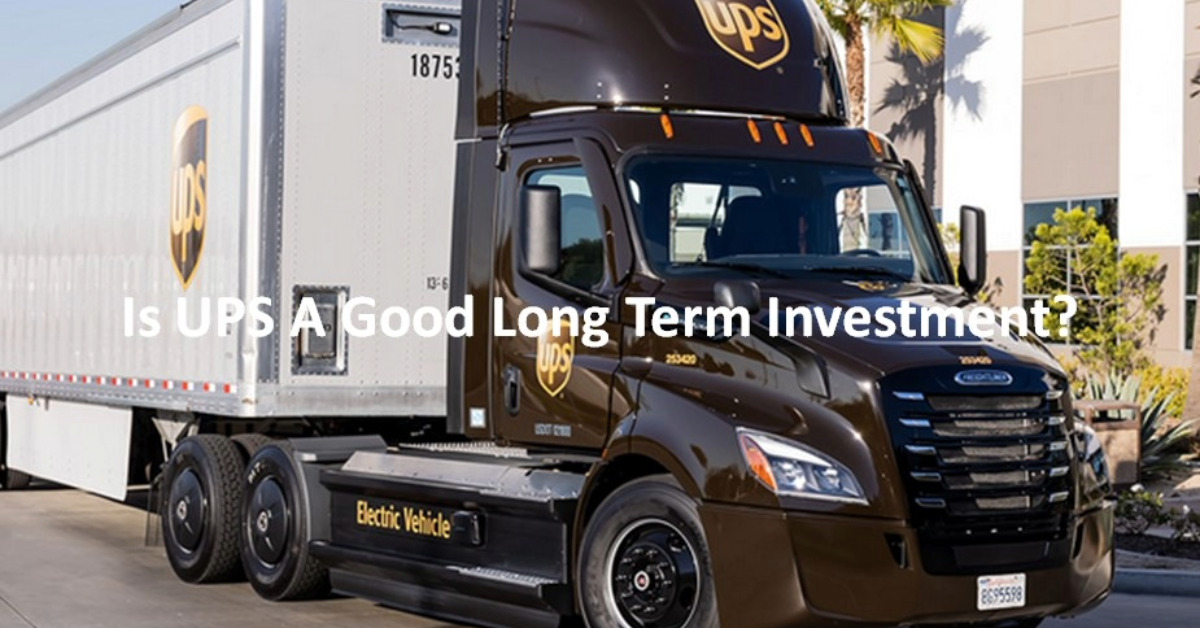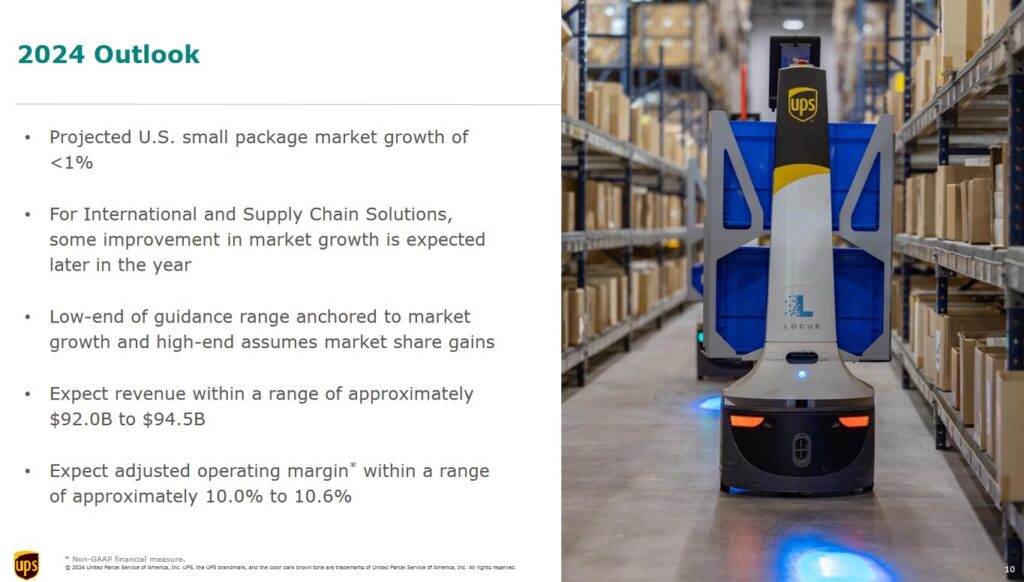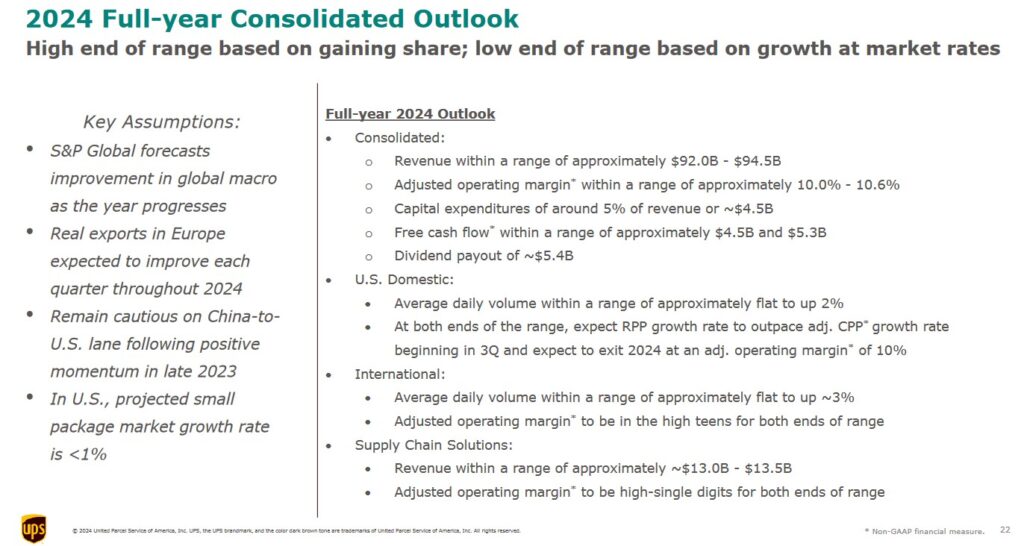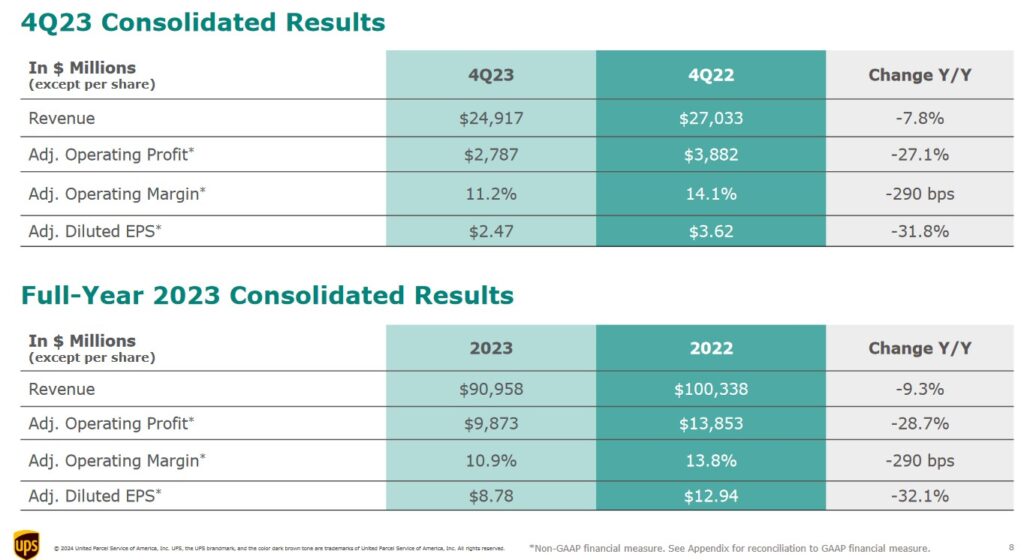Contents

Is UPS A Good Long Term Investment? Until recently, I was a shareholder since at least 2004 and categorically answer ‘NO!’.
I generally invest in companies with the expectation of being a very long term shareholder. Sometimes this has its drawbacks in that I hold investments far longer than I should.
I last reviewed UPS in my February 10, 2022 guest post at Dividend Power and subsequently paid almost no attention to the holding.
When I completed my 2023 Year End FFJ Portfolio Review, UPS was not a top 30 holding (all shares were held in a retirement account for which I do not disclose details). Given my concerted effort to increase exposure to my top 30 holdings, the probability of acquiring additional UPS shares was unlikely.
One of the reasons for performing my 2023 Year End FFJ Portfolio Review was to determine what holdings I needed to cull from my wife’s and my Registered Retirement Savings Plan (RRSP) as part of our RRSP meltdown strategy. I settled upon UPS as being one of the investments to cull and on January 4, 2024, I exited our UPS exposure.
I have touched upon the RRSP meltdown strategy in previous posts but provide the following very high level overview of what we are attempting to accomplish.
The purpose of this strategy is to gradually deplete the value of our RRSPs over the course of several years before the mandatory age by which we must convert the RRSP to a Registered Retirement Income Fund (RRIF) – (December 31 of the calendar year in which you turn 71). In essence, we tailor the amount of the annual RRSP withdrawals to meet our financial needs while ensuring the annual RRSP withdrawals do not place us in the highest tax bracket.
Were we to leave our RRSPs untouched for several more years, we would find ourselves in a predicament where the mandatory minimum annual RRIF withdrawals place us in the highest personal income tax bracket. Add in the income from non-registered investments and the eventual receipt of Canada Pension Plan (CPP) payments, and we will be supporting Canada’s economy to a far greater extent than warranted. As far as the receipt of Old Age Security (OAS) payments when we do elect to start collecting them? We would experience a 100% clawback.
We have employed this strategy for the last 4 calendar years and so far (knock on wood), things have worked out almost as planned. What I did not foresee when we implemented this strategy was that the value of our investment holdings in the RRSPs would appreciate to the extent they have appreciated; despite 4 consecutive years of RRSP withdrawals, the total value of the RRSPs has not changed much. Naturally, we have absolutely no control over how Mr. Market values the companies in which we have exposure. The last 4 years may have been great but who is to say this won’t change as some stage in the future.
While this strategy may be of interest to you, I strongly encourage you to speak with a financial professional who is very familiar with it. There are different ways in which to implement this strategy (some employ the use of leverage). It is, therefore, imperative your course of action meets your specific circumstances.
Although I have exited UPS, it has released its Q4 and FY2023 results and FY2024 outlook on January 30. I, therefore, take this opportunity to briefly revisit this company.
NOTE: UPS has Class A and Class B common stock. Class A shares are restricted to eligible employees. All references to UPS shares in this post relate to the publicly listed Class B stock.
Business Overview
You are undoubtedly familiar with UPS. Nevertheless, I encourage you to review the company’s website and Part 1 Item 1 within the most recent Form 10-K. The FY2023 Form 10-K has yet to be released as I compose this post, however, the FY2022 Form 10-K is accessible here. In addition, I encourage you to review the most recent Proxy Statement and Form 10-Q. These are all accessible through the SEC Filings section of the Investor section on UPS’s website.
Highly Capital Intensive
UPS is a highly capital intensive company with FY2014 – FY2023 annual CAPEX being $2.328B, $2.379B, $2.965B, $5.227B, $6.283B, $6.380B, $5.412B, $4.194B, $4.769B, and $5.158B.
On the bright side, the capital intensive nature of the business creates a significant barrier to entry. Scale leads to cost advantages in that significant fixed costs are spread over millions of packages.
UPS has an immense network of processing facilities and because of the substantial number of packages processed, it has considerably lower unit and marginal costs than a potential new entrant.
Any other company that attempts to replicate UPS’s global parcel shipping network will incur significant financial losses; a new entrant would be required to make a massive investment (ie. planes, sorting facilities, trucks and all other infrastructure elements) before it could win a critical volume of customers from entrenched incumbents.
DHL Express learned this the hard way when in 2009 it decided to exit the U.S. domestic package market following 6 years of sizable losses.
On the downside, the capital intensive nature of the business means UPS MUST spend billions of dollars every year to maintain its competitive advantage.
In FY2023 it spent:
- $0.585B on aircrafts;
- $2.2B on buildings and facilities;
- $1.5B on vehicles; and
- $0.877B on IT.
Financials
Q4 and FY2023 Results
I reference UPS’s Q4 and FY2023 earnings release and earnings presentation.
On the earnings call, UPS’s CEO stated:
2023 was a unique and, quite candidly, a difficult and disappointing year. We experienced declines in volume, revenue, and operating profit in all three of our business segments.
Some of this performance was due to the macro environment, and some of it was due to the disruption associated with our labor contract negotiation, as well as higher costs associated with the new contract.
We see from UPS’s results just how difficult of a year it was.
Given the weak results and FY2024 outlook, UPS announced that it is:
- exploring strategic alternatives for its truckload brokerage business known as Coyote. Coyote is part of supply chain solution and is a business that is highly cyclical with considerable earnings volatility; and
- cutting 12,000 positions (~$1B of cost savings in FY2024).
While this may seem like a lot of employees (especially if you are one of the 12,000), we need to put this figure in perspective.
UPS employees ~536,000 employees (excluding temporary seasonal employees), of which 443,000 are in the U.S. and 93,000 are located internationally. Its global workforce includes ~90,000 management employees (44% of whom are part-time) and ~446,000 hourly employees (50% of whom are part-time). More than 70% of the U.S. employees are represented by unions, primarily those employees handling or transporting packages.
I dispense with a review of UPS’s results because I have exited my position.
Operating Cash Flow (OCF) and Free Cash Flow (FCF)
UPS’s OCF and FCF in FY2014 – FY2023 (in billions of $) is:
OCF: 5.73, 7.43, 6.47, 1.48, 12.71, 8.64, 10.46, 15.01, 14.10, and 10.24.
FCF: 3.40, 5.05, 3.51, -3.75, 6.43, 2.26, 5.05, 10.81, 9.34, and 5.25. Yes…negative FCF in FY2017!
FY2024 Outlook
While FY2023 was a difficult year, the FY2024 outlook suggests another difficult year.
In 2024, the small package market in the U.S., excluding Amazon, is expected to grow by less than 1%. Projected market growth rates for the rest of UPS’s business segments suggest some improvement but not until the latter part of the year.
Furthermore, given the nuances of the new labor contract, there will be stark contrast between the first-half and second-half performance. First-half earnings will be compressed and second-half earnings will expand.

Source: UPS – Q4 and FY2023 earnings Presentation – January 30, 2024

Source: UPS – Q4 and FY2023 earnings Presentation – January 30, 2024
Credit Ratings
Equity investors rank last in order of priority in the event a company defaults on its debt obligations. This is why I look at the debt ratings assigned to a company’s unsecured long-term debt. If this form of debt is non-investment grade then investors must factor into their investment decision-making process their willingness to invest in speculative, highly speculative (or worse) companies!
Before December 2007, UPS’s domestic unsecured long-term debt was assigned Aaa and AAA ratings by Moody’s and S&P Global.
UPS’s domestic unsecured long-term debt ratings are now the middle tier of the upper medium grade investment-grade category:
- Moody’s: A2;
- S&P Global: A (this was upgraded from A- on May 9, 2022).
These ratings are 5 tiers lower than Aaa (Moody’s) and AAA (S&P Global).
These ratings define UPS as having a strong capacity to meet its financial commitments. It is, however, somewhat more susceptible to the adverse effects of changes in circumstances and economic conditions than obligors in higher-rated categories.
The deterioration in UPS’s credit ratings over ~16 years certainly raises eyebrows. The ratings, however, are still investment-grade and I do not expect UPS to default on its obligations any time soon.
Dividend and Dividend Yield
Dividend metrics should not be the primary metrics used to determine if a company is a worthwhile investment. Unfortunately, many investors fixate on dividend yield and consecutive years of dividend increases…often to their detriment.
The appeal of the consecutive number of years of dividends increases has led to terminology such as:
- Dividend Achievers
- Dividend Contenders
- Dividend Aristocrats
- Dividend Champions
- Dividend Kings
Each term defines a company with a different number of consecutive years of dividend increases.
Quite frankly, I think investing based on the consecutive number of years of dividend increases is one of the most asinine ways by which to identify investment opportunities.
Investors should focus on the underlying fundamentals of a company and the total potential investment return. In many cases, companies that do not appeal to dividend investors generate excellent total investment returns. This is because some of these non or low dividend yielding companies can reinvest earnings to generate far superior returns.
Another consideration is the tax implication of dividend income. If shares are held in taxable accounts, the dividend income must be declared annually. If the bulk of the total potential investment return is likely to come from capital gains, any tax liability can potentially be deferred for many, many years.
Of course, every investor has their own investment requirements and dividend income might be necessary. In addition, relying primarily on capital gains means you have to have enough confidence your investments will eventually generate capital gains.
Looking at UPS, we see that it has increased its dividend for 15 consecutive years. Big deal!
On 2 occasions in the past 15 years, UPS increased its quarterly dividend by $0.01 just to keep its consecutive number of years of dividend increases intact.

Source: UPS – Q4 and FY2023 earnings Presentation – January 30, 2024
With shares trading at ~$145, the forward dividend yield is ~4.5%. All the downsides of investing in the company, however, more than outweigh the enticing dividend yield.
The weighted average number of diluted shares outstanding in FY2014 – Fy2023 (in millions of shares) is 924, 906, 887, 875, 870, 869, 871, 878, 875, and 860.
Bear in mind that in FY2022 and FY2023, UPS generated $9.34B and $5.25B of FCF. This exceeded the total return to shareholders by only $0.726B in FY2022 and fell short in FY2023 by $2.372B which resulted in UPS having to borrow to make up the shortfall (see page 27 of 36 – Consolidated Statement of Cash Flows in the Form 8-K) .

Source: UPS – Q4 and FY2023 earnings Presentation – January 30, 2024
Valuation
UPS’s diluted EPS (GAAP) during 2010 – 2023 has been all over the map:
$3.33, $3.84, $0.83, $4.61, $3.28, $5.35, $3.86, $5.61, $5.51, $5.11, $1.54, $14.68, $13.20, and $7.80.
This has led to wild swings in its valuation during 2010 – 2022:
20.86, 17.30, 88.83, 66.93, 27.65, 22.02, 20.43, 29.20, 15.60, 20.36, 31.95, and 13.62.
Having just reported GAAP diluted EPS of $7.80 and with shares trading at ~$146, the diluted PE is ~18.7.
UPS repeatedly has adjustments to its GAAP earnings (eg. Transformation Strategy Costs, Impact of the Tax Cuts and Jobs Act, Benefits Plans – Mark to Market Charges, Legal Contingencies and Expenses, etc., etc.) which can result in adjusted earnings being very different from GAAP earnings.
UPS’s adjusted diluted EPS during 2010 – 2023 is:
$3.48. $4.35, $4.53, $4.57, $4.75, $5.43, $5.75, $6.01, $7.24, $7.53, $8.23, $12.13, $12.94, and $8.78.
Based on FY2023 adjusted diluted EPS of $8.78 and the current share price, the adjusted diluted PE is ~16.6.
When I wrote my guest post on February 10, 2022, the following was UPS’s valuation based on the current ~$225 share price and the forward adjusted diluted earnings estimates from the brokers which cover UPS.
- FY2023: mean of $13.39 and a low/high range of $11.03 – $14.50 from 29 brokers. The forward adjusted diluted PE using the mean estimate was ~16.8.
- FY2024: mean of $13.74 and a low/high range of $10.37 – $15.68 from 8 brokers. The forward adjusted diluted PE using the mean estimate was ~16.4.
We see from those estimates and UPS’s actual results that trying to reasonably estimate UPS’s future earnings is a crapshoot. The FY2023 mean adjusted diluted EPS estimate was $13.39 but UPS only generated $8.78!
Some of the brokers have lowered their earnings estimates following the release of UPS’s results and I envision further adjustments are forthcoming. For now, however, UPS’s forward adjusted diluted PE levels using the current ~$145 share price are:
- FY2024: mean of $8.63 and a low/high range of $7.00 – $10.54 from 31 brokers. The forward adjusted diluted PE using the mean estimate is ~16.8.
- FY2025: mean of $9.99 and a low/high range of $8.02 – $11.23 from 27 brokers. The forward adjusted diluted PE using the mean estimate is ~14.5.
- FY2026: mean of $11.35 and a low/high range of $9.90 – $12.51 from 9 brokers. The forward adjusted diluted PE using the mean estimate is ~12.8.
I have never relied on earnings estimates that are well into the future. Based on my experience with UPS, even relying on earnings estimates that are only a year into the future has its challenges.
Just looking at the variance in earnings estimates, it is apparent the brokers which cover UPS also have a difficult time trying to estimate the company’s future adjusted earnings.
Final Thoughts
UPS might be an industry leader. There are, however, so many things about the company not to like (highly capital intensive, earnings and FCF all over map, militant union, etc.). In addition, the FY2024 outlook does not give me much comfort even though management expects material improvement as the year progresses with the second half of the year outperforming the first half.
The world has changed considerably from when I initiated my UPS investment roughly 2 decades ago. In hindsight I should have paid more attention to this holding over the years. Had I done so, I likely would have exited my exposure a long time ago rather than at the beginning of 2024.
In my recent ServiceNow post, I concluded with Warren Buffett’s and Charlie Munger’s advice that
It’s far better to buy a wonderful company at a fair price than a fair company at a wonderful price.
They didn’t say to buy a wonderful company at ANY price.
In the case of UPS, the company isn’t that wonderful even though it might be an industry leader. You may want to pass on UPS and to cast your net wider.
I wish you much success on your journey to financial freedom!
Note: Please send any feedback, corrections, or questions to finfreejourney@gmail.com.
Disclosure: I do not have exposure to UPS and do not intend to initiate a position within the next 72 hours.
Disclaimer: I do not know your circumstances and am not providing individualized advice or recommendations. I encourage you not to make investment decisions without conducting your research and due diligence. You should also consult your financial advisor about your specific situation.
I wrote this article myself and it expresses my own opinions. I am not receiving compensation for it and have no business relationship with any company whose stock is mentioned in this article.


